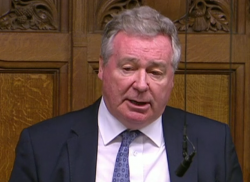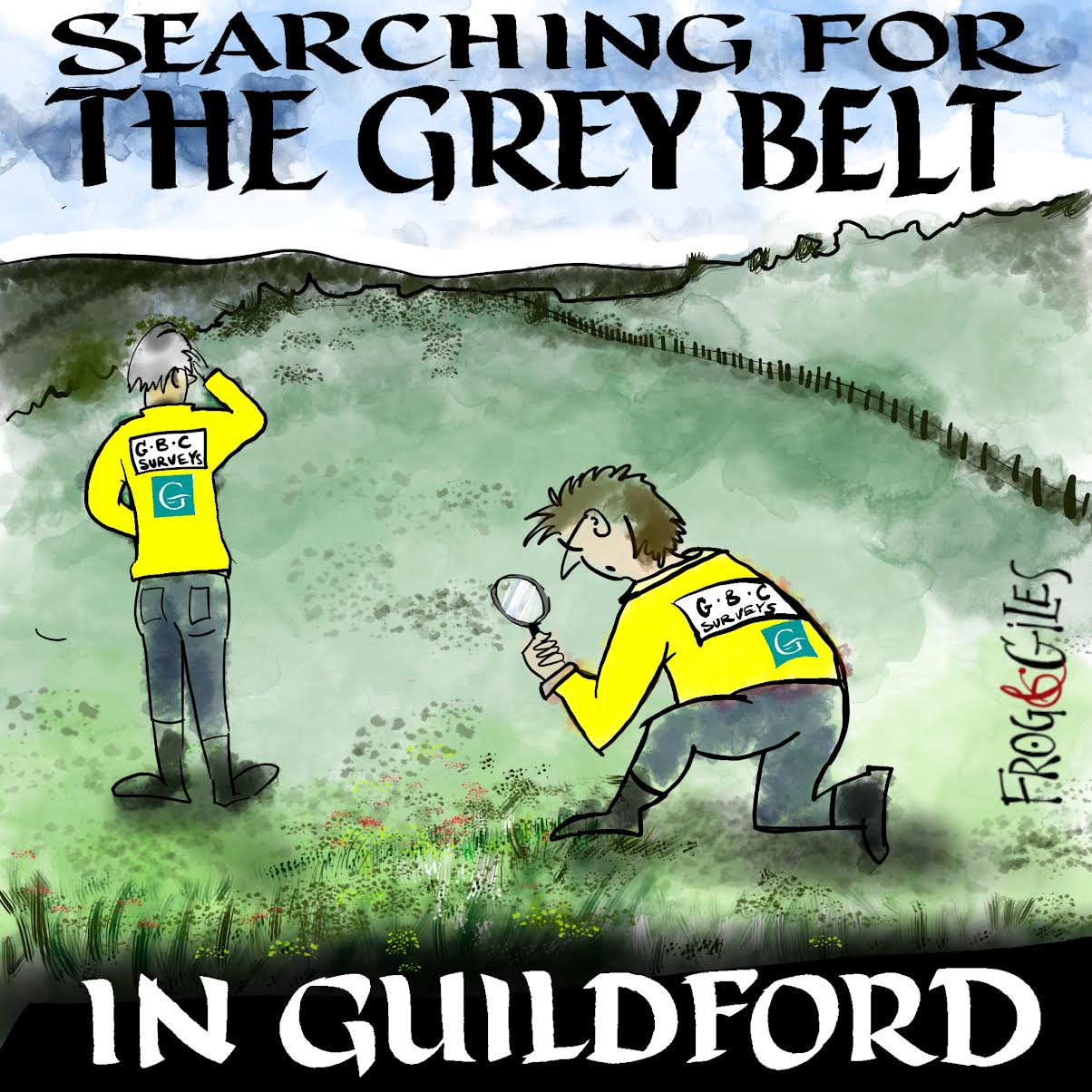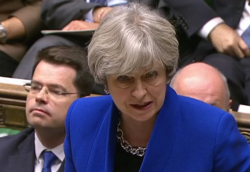 Abraham Lincoln
If given the truth, the people can be depended upon to meet any national crisis...
Abraham Lincoln
If given the truth, the people can be depended upon to meet any national crisis...
 Guildford news...
for Guildford people, brought to you by Guildford reporters - Guildford's own news service
Guildford news...
for Guildford people, brought to you by Guildford reporters - Guildford's own news service
Opinion: Who Is Guildford’s Local Plan Satisfying?
Published on: 30 Dec, 2017
Updated on: 2 Jan, 2018
It is not every day that Guildford is specifically mentioned at prime minister’s question time.
Normally when Conservative MPs name a particular Tory constituency, usually their own, it is to point out some success which they offer up as evidence of the government’s success – in Ashes terms an easy long hop between the fast balls and googlies from the opposition.
The prime minister then indulges in a bit of mutual back-slapping and agrees with his or her honourable friend. It is all a traditional part of the ritual.
So what are we to make of Sir Paul Beresford’s question last week on Guildford’s Local Plan and green belt protection?
To remind you, he asked Theresa May: “…I believe it is common knowledge that the Conservative party is the party that strives to protect our green belt. It was therefore a shock to me and a vast number of my constituents in the Guildford wards of Mole Valley when Guildford Borough Council submitted its draft Local Plan.
 “The council seeks to build 57% of the houses in its plan on green belt. Does my right honourable friend agree that local authorities should focus their imaginations on developing buildings of sufficient height, density and imagination on brownfield sites, not green belt?”
“The council seeks to build 57% of the houses in its plan on green belt. Does my right honourable friend agree that local authorities should focus their imaginations on developing buildings of sufficient height, density and imagination on brownfield sites, not green belt?”
Sir Paul was careful to say that he was referring to the five GBC wards that lie in his Mole Valley parliamentary constituency, even though the 57% figure is for the whole borough. We can only speculate whether Guildford’s MP, Anne Milton, knew about the question before it was asked, but she seems determined to stay out of the Local Plan arguments, and she can’t lose votes in those eastern parts of the borough that aren’t in her constituency.
But the prime minister herself will have almost certainly have been aware of what was coming. Most questions at PMQs, other than the six from the leader of the opposition, are selected by ballot, although determined backbenchers can sometimes succeed by “bobbing” up and down from their bench to try and catch the speaker’s eye.
Sir Paul’s question did not appear to be one of those; the prime minister seemed to know what was to be asked and had a considered answer prepared.
Here it is: “My honourable friend is right to raise this issue on behalf of his constituents. As he will know, a local authority may alter a green belt boundary only in exceptional circumstances. In our housing White Paper, we were very clear that this means “when they…have examined fully all other reasonable options for meeting…identified development” needs. Of course, that includes looking at and building on brownfield sites.
“In the case of Guildford, I understand that the Local Plan was submitted for examination earlier this month, and of course it will be examined by an independent inspector for soundness in due course. I can assure my honourable friend that he is absolutely right that we want to ensure that green belt is protected.”
Superficially, at least, it appeared that the PM was supporting Sir Paul’s view, that his “shock” was justified. Perhaps mindful of growing concern even among dyed-in-the-wool Conservatives in the Home Counties, and the recent Surrey council leaders’ claim that Surrey is already “straining at the seams”, she explicitly said he was right to raise the matter.
Her explanation of the justification of green belt changes would also seem to imply some criticism of the proposed changes in the submitted Local Plan, especially as she reiterated that, “…a local authority may alter a green belt boundary only in exceptional circumstances.”
The leader of Guildford Borough Council, Paul Spooner, might have been left feeling deserted by his party leader. If the party leadership was not satisfied with Guildford’s locally unpopular plan what had been the point of reneging on election pledges and ignoring most of the thousands who had made their views known?
Why stick with a secret calculation of housing need many have no faith in and which they believe has led to an inflated target? Had he got it all wrong? Wasn’t it the changes to planning policy made by the Conservatives that had set the trajectory he had loyally followed?
 But before the green belt campaigners and sympathisers are too quick to jeer, the PM’s definition of “exceptional circumstances” is worth pondering too. She said: “In our housing White Paper, we were very clear that this means ‘when they…have examined fully all other reasonable options for meeting…identified development’ needs.” So it seems that development need can sometimes be considered an “exceptional circumstance”, something others have previously denied.
But before the green belt campaigners and sympathisers are too quick to jeer, the PM’s definition of “exceptional circumstances” is worth pondering too. She said: “In our housing White Paper, we were very clear that this means ‘when they…have examined fully all other reasonable options for meeting…identified development’ needs.” So it seems that development need can sometimes be considered an “exceptional circumstance”, something others have previously denied.
Even if developers prefer it as more profitable, no one has argued that it is better to build on green belt (or even green fields, as in Ash) than redevelop brownfield sites. GBC has calculated that more than 3,300 homes could be built on brownfield sites listed in its register but, unfortunately, brownfield development is not as straightforward as it might seem.
Firstly, unless the council owns the land, it cannot insist it is redeveloped or redeveloped as housing. The owners of the land may wish otherwise with legitimate reasons, commercial or otherwise. Unless there is new legislation that will remain the case.
Secondly, not all “brownfield land” comprises derelict, unused land, such as areas to the north of North Street or at the bottom of the Portsmouth Road near the Cannon pub. Land intended to give Guildford Cathedral a green setting is on the brownfield register but a planning application for a housing development there was very unpopular with local residents and was overwhelmingly rejected by GBC’s Planning Committee.
Some mention car parks as suitable brownfield sites and it is true that they do take up valuable space but they are also needed. Visitors to Guildford often complain about the lack of parking, so unless there are effective measures, including subsidised public transport (and where would the money come from for that?) it is hard to imagine the often mentioned “modal shift”, away from cars, having any real impact in the foreseeable future.
As for more higher-rise buildings, if that is what Sir Paul meant when he said, “buildings of sufficient height”, for many of us the higher-rise buildings we have in Guildford represent some of the poorest planning decisions of the last 50 years, an entire half-century of town centre planning ineptitude. Surely we don’t want to repeat those errors; nothing could do more damage to our townscape, one only has to consider the Solum proposal for the railway station.
But there are some changes the PM could oversee to encourage brownfield development and decrease pressure on the green belt. The government could create tax penalties for those who fail to build out developments that have been granted permission (permission for 313 homes has been granted for sites on the GBC brownfield register) and allow compulsory purchase of suitable fallow sites that may have been “land banked” (ie left undeveloped until development is even more profitable).
But such changes even if introduced will come too late for Guildford. Our Local Plan has been submitted and for whatever flaws there may be in the national planning policy, or the plan itself, a planning inspector is the man who may end up with the most influence over how our borough will develop over the next 20 years. Can that be right in a democracy?
And some may say why even bother trying to plan for decades hence when none of us knows the outcome and impact of Brexit?
Responses to Opinion: Who Is Guildford’s Local Plan Satisfying?
Leave a Comment Cancel replyPlease see our comments policy. All comments are moderated and may take time to appear.

"Found any?" - "Nope, it all looks green to me!" (See Opinion: The Future is Congested, the Future is Grey)




Recent Articles
- Mayor’s Diary – November 17 to December 1
- Ben Tries a Beryl
- Letter: Many Residents Appreciate LRAG
- Sara Sharif Trial Latest – Sara ‘Had a Different Status’ to Her Siblings
- Surrey Postcard Club’s Fair is Back, November 23, East Horsley Village Hall
- Guildford Residents Left Stranded After Heathrow Bus Breakdowns
- Mole Valley’s Finance Director Warns ‘All the Low Hanging Fruit Is Gone’
- Have Some Time to Volunteer?
- Council Tax Hike Not Currently Planned Despite ‘Black Hole’
- I Am Stella Kuchanny, The Dragon’s Newest Reporter


Recent Comments
- John Perkins on Letter: LRAG Has Morphed from a Cross-community Group into a Pressure Group
- Ben Paton on Letter: Many Residents Appreciate LRAG
- Roger Carnegie on Surrey County Council ‘Backed Down’ Over London Road Scheme Call-in
- Maddie Evans on Shalford War Memorial Restored Ready for Remembrance Sunday
- Jane Hepburn on Guildford Residents Left Stranded After Heathrow Bus Breakdowns
- Jane Hepburn on I Am Stella Kuchanny, The Dragon’s Newest Reporter
Search in Site
Media Gallery
Dragon Interview: Local Artist Leaves Her Mark At One of England’s Most Historic Buildings
January 21, 2023 / No Comment / Read MoreDragon Interview: Lib Dem Planning Chair: ‘Current Policy Doesn’t Work for Local People’
January 19, 2023 / No Comment / Read MoreA3 Tunnel in Guildford ‘Necessary’ for New Homes, Says Guildford’s MP
January 10, 2023 / No Comment / Read More‘Madness’ for London Road Scheme to Go Ahead Against ‘Huge Opposition’, Says SCC Leader
January 6, 2023 / No Comment / Read MoreCouncillor’s Son Starts Campaign for More Consultation on North Street Plan
December 30, 2022 / No Comment / Read MoreCounty Council Climbs Down Over London Road Works – Further ‘Engagement’ Period Announced
December 14, 2022 / No Comment / Read MoreDragon Interview: GBC Reaction to the Government’s Expected Decision to Relax Housing Targets
December 7, 2022 / No Comment / Read MoreHow Can Our Town Centre Businesses Recover? Watch the Shop Front Debate
May 18, 2020 / No Comment / Read More








Stuart Barnes
January 1, 2018 at 10:22 am
According to Migration Watch (about the only unbiassed organisation following such things) 82% of future housing needs will be from migration. Thus, in theory at least, once we are out of the EU and are allowed to control our own borders and destiny again, that pressure will go as we put up the already full sign to potential new arrivers. So let’s encourage our MPs to get us out asap even without a deal.
An alternative view of course, from the Guardinistas and others on the left such as the BBC, is that Brexit will be such a discouragement that the people wanting to come here now will stop coming and some of those here already will leave.
Either way in the long run we will be better off to wait before considering building on what is left of our countryside and green belt.
Jules Cranwell
January 1, 2018 at 3:17 pm
Unfortunately, Cllr Spooner has slavishly followed the ‘trajectory’ set by the leadership of former councillor Mansbridge and his disgraced colleague Juneja. This trajectory dances only to the tune of developers, and ignores the will of residents. We deserve to be told why. What are they hiding in the secret housing need calculations?
Sue Wright
January 3, 2018 at 5:11 pm
This link to a Migration Watch report makes interesting reading. Perhaps our MPs should read it too
http://www.migrationwatchuk.org/briefing-paper/424